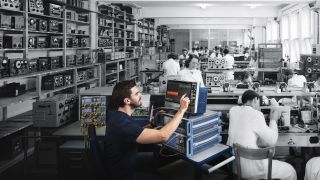The real internet of things
The internet of things has been around conceptually for a good while already. Now it is also gradually taking shape in the real world too. Especially in industry and in transport, its growth should be accelerated by 5G. Smart home and smart city applications will also make their own contributions. However, even then it would still be too early to speak of all-encompassing connectivity. That is part of the 6G vision. Based on its technical configuration as well as its capacity, 6G should be capable of integrating an arbitrary number of devices in every imaginable category. Everything we wish to have contact with or which plays a role in our lives – encompassing private, commercial as well as public contexts – is a potential candidate for connectivity. Take, for example, bridges and highways. How is their current condition? When do they need to be repaired and where? Embedded radio sensors could provide the relevant information. The RFID tags commonly used in retail sales and logistics can only be read from a short distance. Equipped with special sensors and a larger range, however, they could be used to monitor the quality of foodstuffs and send relevant reports, for example.
The last example simultaneously involves multiple areas of current research. If a small movable object is monitored to be able to take it out of circulation when necessary, its exact position must be known. Many other applications also require information about the location of the communications partner since 6G services will generally be provided on a local basis. For technical reasons, 6G will use highly focused directional radio beams in order to target the radio energy towards specific remote stations. A 6G network will thus include a radio network as well as a sensor network that is capable of determining the position of radio users with centimeter accuracy in 3D space. The techniques to be used for this purpose are still under investigation, but radar technology in the access points is one possibility.
Another problem related to mass deployment of radio sensors involves how to supply them with energy. The sheer quantity of these devices as well as the degree of miniaturization makes it unfeasible to exchange the power cells. However, since many applications are conceived for long-term deployment over many years in some cases, the sensors must be able to provide their own power. Zero energy device and energy harvesting are relevant buzzwords here. Modern RFID sensors are designed to function in this manner, but they are directly supplied with electromagnetic energy by a nearby reader device. 6G sensors will have to make do without this convenience and obtain power from suitable local sources such as heat, light or motion. Like many other 6G topics, research in this area is still in the early stages. Nevertheless, T&M equipment from Rohde & Schwarz is already helping us understand the energy consumption patterns of devices, making low-power design possible.

















